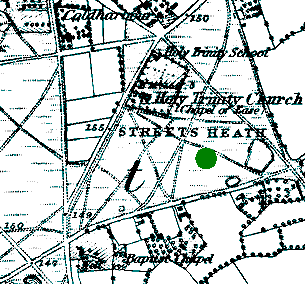  The
village started life as a sparse collection of farmsteads on what became known as the
"West End Of Chobham"
("End" simply means outlying place), the picturesque village where evidence of a
settlement stretches back to the Bronze Age. Chobhams' borough originally covered a large
area both to the east and west, once simply part of the huge tract of open country called
the Forest Of Windsor which ran roughly between Guildford, Henley, Staines and Maidenhead. The
village started life as a sparse collection of farmsteads on what became known as the
"West End Of Chobham"
("End" simply means outlying place), the picturesque village where evidence of a
settlement stretches back to the Bronze Age. Chobhams' borough originally covered a large
area both to the east and west, once simply part of the huge tract of open country called
the Forest Of Windsor which ran roughly between Guildford, Henley, Staines and Maidenhead.
 Long-held rights ensured locals used
West End Common extensively to build their homes and
graze their livestock. Much stone, sand and gravel was removed, and turfs and small trees
were regularly "harvested". This
continuous activity over many centuries was important to
the economy of the poorer peoples of West End and was a major factor in the way the Common
developed into its individual heathland character seen
today. The Common was crossed in all directions by ancient paths and roads,
of which Brentmoor Road gave an easy route to
Frimley and Pirbright. Spaces in the area that now centres just south of the famous
Gordon's School
(on the A322/A319 junction) gradually started filling in between the
farmsteads as more of the poorer Chobham
parishioners looked to improve their lot. Long-held rights ensured locals used
West End Common extensively to build their homes and
graze their livestock. Much stone, sand and gravel was removed, and turfs and small trees
were regularly "harvested". This
continuous activity over many centuries was important to
the economy of the poorer peoples of West End and was a major factor in the way the Common
developed into its individual heathland character seen
today. The Common was crossed in all directions by ancient paths and roads,
of which Brentmoor Road gave an easy route to
Frimley and Pirbright. Spaces in the area that now centres just south of the famous
Gordon's School
(on the A322/A319 junction) gradually started filling in between the
farmsteads as more of the poorer Chobham
parishioners looked to improve their lot.
 |
WECC's current wicket is indicated by the
green dot. Click above for an enlarged map view that includes the whole locality. (203k) |
|
 Near
the bottom of the map (c.1873) you can see the Streets Heath road off which is the
Baptist
Chapel which dates from around the start of the 19th century. It closed around the time of
the Great War. Near the top is seen Holy Trinity
Church, consecrated in 1842 and extended
many times over the years. Originally, this "Chapel Of Ease" had a gallery and
its clerical needs were administered by successive Chobham vicars who were assisted by
curates. The last wooden grave board was preserved and now resides in the Surrey Heath Museum at
Camberley. A Vicarage was to be
built on the land next to Holy Trinity, at the junction of Benner Lane and what is now the
A319 Chobham road. This never happened and Holy Trinity School was erected instead with
the help of The National Society around 1845. Before then, children needed stout footwear
to walk miles into chobham, often in the dark on the notoriously poor local tracks. Near
the bottom of the map (c.1873) you can see the Streets Heath road off which is the
Baptist
Chapel which dates from around the start of the 19th century. It closed around the time of
the Great War. Near the top is seen Holy Trinity
Church, consecrated in 1842 and extended
many times over the years. Originally, this "Chapel Of Ease" had a gallery and
its clerical needs were administered by successive Chobham vicars who were assisted by
curates. The last wooden grave board was preserved and now resides in the Surrey Heath Museum at
Camberley. A Vicarage was to be
built on the land next to Holy Trinity, at the junction of Benner Lane and what is now the
A319 Chobham road. This never happened and Holy Trinity School was erected instead with
the help of The National Society around 1845. Before then, children needed stout footwear
to walk miles into chobham, often in the dark on the notoriously poor local tracks.
 Around
this time cricket gets mentioned in a journal of the day and this could mean that the game
had been played in the village for some while, even then. A railway link between Staines,
Bagshot and Woking was proposed, along with a station at West End, however it never
materialised. Presumably this was the same project that the ticket-office at Chobham (now
the Castle Grove public house) was built for. 1860's records show ten occupations,
including farmer and labourers, shoemaker, blacksmith, hawker, carpenter, sawyer and
shopkeeper. There were also two public houses since the early 19th century, both of which
in use today.round
this time cricket gets mentioned in a journal of the day and this could mean that the game
had been played in the village for some while, even then. A railway link between
Staines,
Bagshot and Woking was proposed, along with a station at West End, however it never
materialised. This was part of the same project that the ticket-office at Chobham (now
the Castle Grove public house) was built for. 1860's records show ten
occupations in West End,
including farmer and labourers, shoemaker, blacksmith, hawker, carpenter, sawyer and
shopkeeper. There were also two public houses since the early 19th century, both of which
in use today. Around
this time cricket gets mentioned in a journal of the day and this could mean that the game
had been played in the village for some while, even then. A railway link between Staines,
Bagshot and Woking was proposed, along with a station at West End, however it never
materialised. Presumably this was the same project that the ticket-office at Chobham (now
the Castle Grove public house) was built for. 1860's records show ten occupations,
including farmer and labourers, shoemaker, blacksmith, hawker, carpenter, sawyer and
shopkeeper. There were also two public houses since the early 19th century, both of which
in use today.round
this time cricket gets mentioned in a journal of the day and this could mean that the game
had been played in the village for some while, even then. A railway link between
Staines,
Bagshot and Woking was proposed, along with a station at West End, however it never
materialised. This was part of the same project that the ticket-office at Chobham (now
the Castle Grove public house) was built for. 1860's records show ten
occupations in West End,
including farmer and labourers, shoemaker, blacksmith, hawker, carpenter, sawyer and
shopkeeper. There were also two public houses since the early 19th century, both of which
in use today.
|

